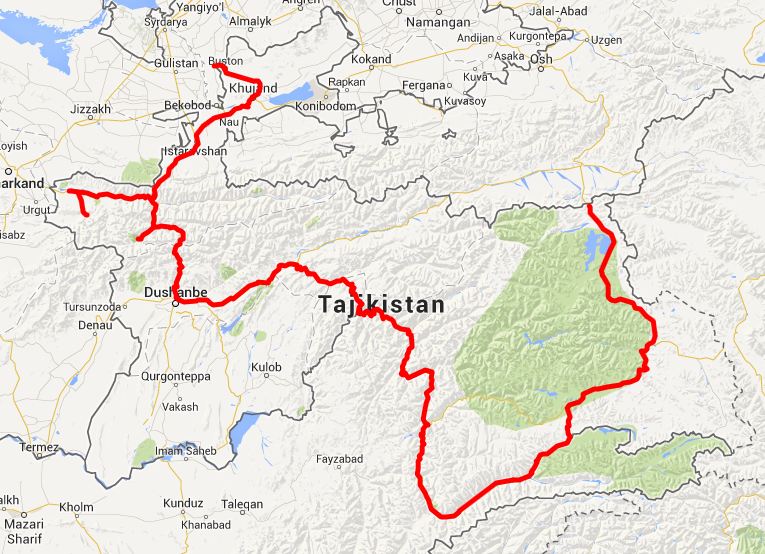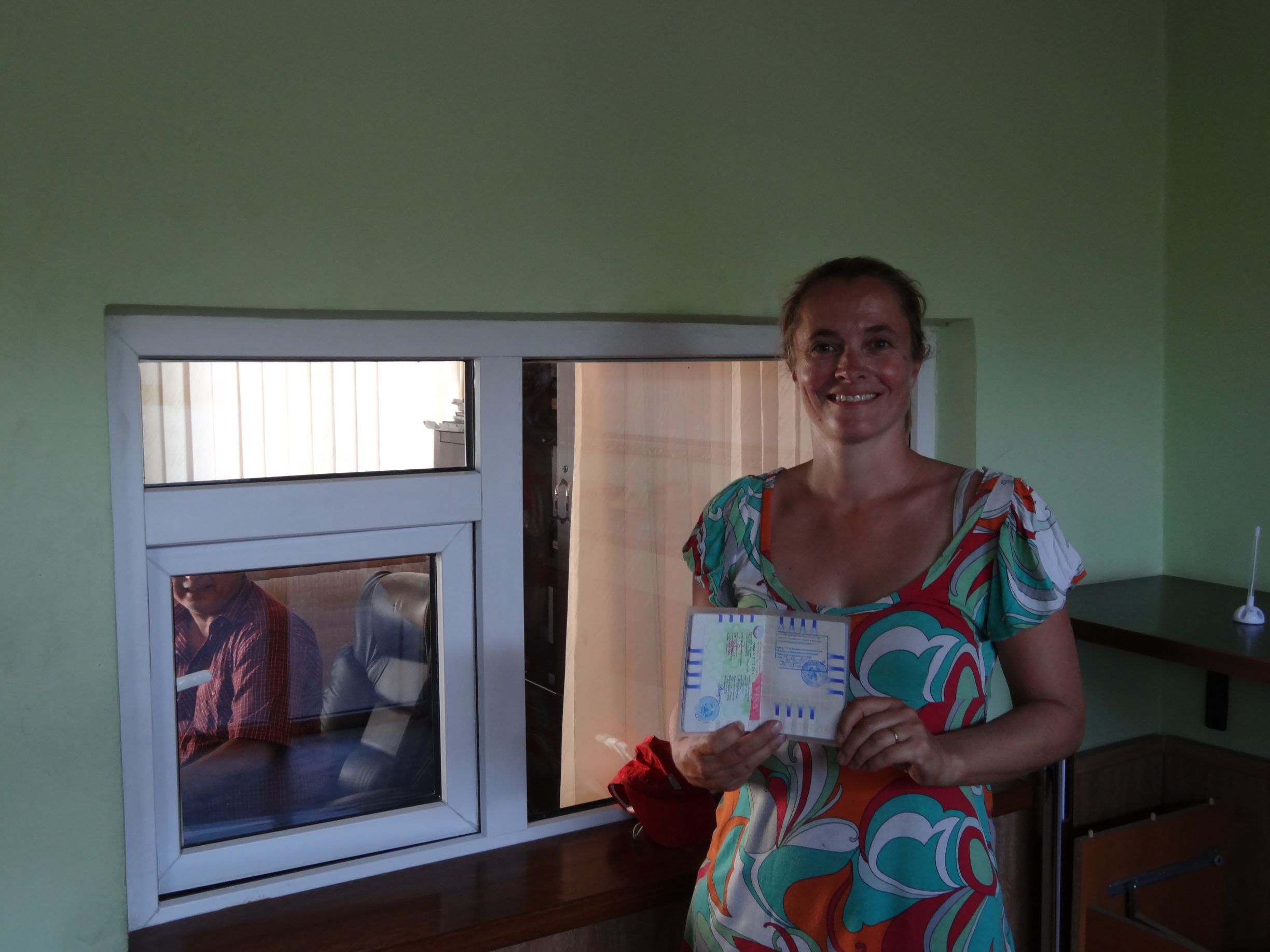Tajikistan
Our route in Tajikistan
This is the route we drove in Tajikistan. If you are interested, you can click on this image below and it will take you to the actual Google Map online. You can then zoom in (or out) to have a more detailed look.
Visa
In the end we applied for our visa for Tajikistan in Almaty. We tried in Astana as well, but the consul was out of town at the time (he was actually in Almaty we were told) and they couldn’t help us that day. They were very friendly and would have most certainly been able to help if he would have been there (or that was at least the impression given to us).
In Almaty we went straight to the Tajik embassy (coordinates of the Tajikistan consulate in Almaty: N43 12 07.9 E076 54 48.8) and again were met by very friendly people. They confirmed we could apply for our visa for Tajikistan, including the GBAO permit for the Pamir Highway and we would be able to pick up our passports 2 days later. But when we asked if it would be possible to pick them up the next day, they offered an after 2pm pickup with no extra charge. Fantastic. The cost per person (including GBAO permit) was $55 for a single entry visa. And we didn’t need an LOI.
apply for visa in Bishkek – Kyr (no LOI needed, next day) or Almaty – Kaz (LOI needed, same day)
We have been in contact with the embassy of Tajikistan in Bishkek and they have confirmed we don’t need a LOI for a tourist visa and it can be done in 1 day. We’re now trying to find out if the same applies for the GBAO permit and the cost for both, but this has been a great confirmation from posolstvo@ktnet.kg.
Border crossing from Tajikistan into Uzbekistan (Khojand)
Please read about this border crossing on the Uzbekistan page.
Border crossing Kyrgyzstan – Tajikistan
We arrived unexpectedly at the Kyrgyz border post at 3450m. It’s a very small and friendly border post. The gate is closed, but after a few minutes a guard came to open it for us.
We parked undercover (as usual) and gave our passports and car papers to the customs officer. He took them inside into his office with a big Kyrgyz flag on the wall. After the usual questions about where we had come from, where we were going and where we had been in Kyrgyzstan, he entered some information into a book and kept the temporary import paper we had received on entry.
We looked for exit stamps in our passports but didn’t see any, so asked about it. For immigration we had to go to the next building. Jon drove the car the 50m and I walked over. Immigration is in the building behind the building you see first. It wasn’t immediately obvious, but the guys were pointing towards the right building. We had to find somebody to help us, but once we had found somebody, but he soon arrived from the gatehouse. Another minute and we had our exit stamps.
That was it. No car customs control forms, no checking of the car inside. Nothing. A friendly “finished” and “goodbye”, the gate was opened for us and we were into no-man’s land. This time no-man’s land was quite long: 19km.
Including all the friendly chatting and questions it had taken us less then 10 minutes to cross this border.
After the Kyrgyz section we had to drive over the Kyzyl-Art pass at 4282m before dropping down again to 4174m to get to the Tajik border post. This no-man’s land section was 19 km. Almost as long as the one between Mongolian and Russia (Altai area).
It all started very friendly. The gate was opened and we were pointed to the low white building on the left where we were invited to sit down. The officer wrote down our passport details and car details in his book whilst we sat on his bed. He wanted a lift down, but as we have no spare seats we couldn’t take him so we were sent on. We asked where we would get our car papers and they pointed past the big buildings to the building with the blue roof (we thought).
It turned out we needed to be in the containers next to it, but as we drove a few meters past the white container we heard whistling and they came running out. Inside they immediately tried to tell us we needed to pay ‘straf’, Russian for fine. But we didn’t know what they were talking about of course and after trying a few more times whilst writing our details into yet another book they gave up and sent us into the cold again. We asked for our car papers again and they pointed to the next white building, just before the ‘slagboom’ (gate).
In there we found another officer who took down all our details. He had 4 books into which he copied different details, even copying numbers from one book into the next. I wish I could have taken some photos in there. When he was finished he tried to send us onwards, but we again asked for our car papers. At every border we have received some sort of temporary import papers so we wanted them here as well.
Turned out the forms were finished… that’s maybe why he tried to send us on. Anyway, we asked if they could write that on a piece of paper as we might otherwise get problems when leaving Tajikistan and he was ok with that.
He must have done it before as he took out an A4 sized piece of paper, folded it in half, put carbon paper in between, clipped it into a board and started writing. He was essentially copying an old form that had already been used. He stamped it so hopefully this won’t give us any problems. For this privilege we had to pay $25, either in someni, som or dollars…
We were then told we also needed a form and certificate of the transport police. We tried to explain to them we already had the GBAO permit, but they were adamant we needed this certificate with form attached. It would cost us another $20. We paid.
We’re not sure if we got ripped off here as we already have the GBAO permit and this seems to do pretty much the same (it has a map of the Pamir Hghway on the back of the form), but we didn’t want to get into any problems later when they check our papers. I write ‘when’ as it is not a question of ‘if’ we are being checked, we will be checked, it’s just a question of when.
Maybe we got ripped off, maybe they are pretty good in their ‘get-money-out-of-tourists’ scheme, but the certificate looks pretty official so we fell for it.
After the details were all filled into the certificate and the form we even got a receipt for the money, maybe it wasn’t a rip-off scheme after all? We had both names written on the form where it says ‘driver’ as we don’t want to get unstuck with that either (too paranoia, who knows?).
After that we were free to go, again no checks at the gate and nobody who even wants to look inside the car. The gate was open and we drove out and into Tajikistan!
Sim card
At first we didn’t want to buy a local sim card in Tajikistan, but due to the need to send some emails by the time we arrived in Penjakent and the lack of internet facilities in this town and the whole area, we had to go into town after all and buy one. The first office we saw was from Tcell, the same company that also has for example Kcell in Kazakhstan. It was a modern looking office and we decided to try our luck.
First we were told we couldn’t buy a sim card unless we had a Tajik passport, but after some gentle pleading we were told they would help us. It took us 3 hours to set it all up, but it worked fine, including data. They had sold us somebody else’s old number as we needed a small sim card for the iphone 4, it was a ‘good’ number so we had to pay 30 someni for it (about $6). Adding data was another 45 someni, which gave us 1Gb. We didn’t need that much, but it was the smallest amount we could get.
Fuel
Although fuel stations can be very rudimentary, with the diesel being poured into your trusty vehicle using a jerrycan and a funnel after it was siphoned out of a massive drum, we never had any problems with quality. We paid anywhere between 5 someni around Khojand and 6.80 someni in the Pamir area.
Roads in Tajikistan
As usual they vary, a lot. The Pamir highway is mostly tarmac, but as the Chinese trucks thunder over it day and night it does get a hammering and road quality is not great. The Wakhan valley is mostly dirt road, just wide enough for one car. One of the vehicles generally needs to back up when passing each other. The same goes for the road from Khorog to Dushanbe (the ‘northern’ route).
From Dushanbe you’ll find perfect tarmac towards Khojand, but unfortunately the Zorafshan Valley is a terrible road, making access to the Fan Mountains still quite tedious and slow. They are working on a tarmac road (in October 2013) and this should be finished in the next year or so (we’ve been told). Only a few kilometers were tarmac now.
Food and Shopping
Murghab has no shopping worth mentioning. You might find some veg on the local bazaar, but bring what you need if you are starting your Pamir journey from Osh. Khorog had some small shops where you’ll be able to find the basic necessities and Dushanbe is another step up, even has some small supermarkets (which are quite expensive as they cater for the expats it seems). The bazaar here will get you most of the things you need.
The times we ate out (Khorog, Dushanbe and Penjakent) were ok, but no better than that. You can find a decent meal in Dushanbe, but everywhere else you’ll only be able to get local food. Don’t get us wrong, normally we love eating local, but after many months of only plov on the menu we are not very interested any more. Jude has an even harder time as vegetarians are unknown aliens here. She is lucky if they can make a salad of sorts and get some fried eggs with bread.



Dear Jon & Jude, I came across the pictures of your trip to Tajikistan and I saw a very good one with the ruins of an ancient house at Sarazm. That picture would be very useful for a publication I’m going to submit, therefore I wonder if you could be so kind as to authorize me to publish it and, in case you do, to give me information about the credit (Courtesy …).
I thank you a lot in advance and hope to hera from you soon,
Ciro
Hi Ciro, no problem. I am not sure which image you are talking about. Can you send us an email with the image perhaps? We can also send you the full-sized image if you need. We can then also tell you who to credit. Thanks for contacting us. Cheers, Jon & Jude